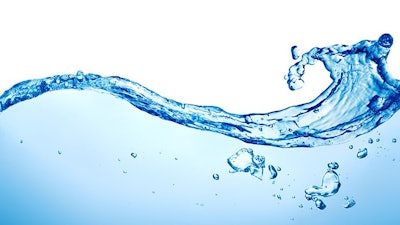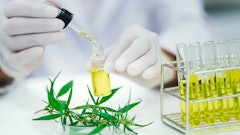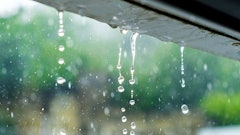
Minimizing water use in cannabis cultivation not only reduces the impact on the environment, but it could also help growers comply with state and municipal regulations, as well as reduce costly water bills.
Here, Nic Easley, CEO of Comprehensive Cannabis Consulting (3C), and Duncan Gordon, chief operating officer of Sunniva, a vertically integrated medical cannabis company with cultivation and extraction facilities in California and Canada, offer insight into maximizing water efficiency in grow facilities.
1. Know your water source.
All cultivators should have their water source tested prior to using it on their crop, Easley says. This will help identify which filters are needed to make the water safe for use.
“Know your water source, and then test it,” he says. “What kind of filters do you actually need? Do you need reverse osmosis, or could you just be doing basic filtration? Or is the iron concentration in your well too high?”
If the iron concentration in well water is too high, for example, it can cause nutrient lockout in the plants, where they cannot absorb nutrients.
“I like testing my media … to see what pH I’m at, what salinity I’m at,” Easley says. “Do I need to flush and use more water? Testing for a basic water profile is going to tell you your calcium, your magnesium, your irons, your lead.”
Growers should test their water on a regular basis—once per quarter, for example—and use the readings to adjust factors accordingly, such as the pH and nutrients.
2. Use a fertilizer recipe based on the crop’s needs.
Cultivators should look to select a site that already has water suitable for crop production, and build a fertilizer recipe based on the crop’s needs by supplementing what is already present in the water, Gordon says.
3. Recirculate irrigation water for future use.
“Re-circulation of nutrient solution is a no brainer,” Gordon says. “With the use of ultraviolet radiation or ozone treatment, nutrient-rich water does not need to be wasted, preventing the dumping of nutrient-rich water into the sewer.”
As states and municipalities start regulating water use in cannabis cultivation, a no “drain to waste” policy is a common standard that is emerging, Gordon says. Drain to waste is the practice of discarding nutrient solution or irrigation water into municipal sewers or septic systems after it has been fed to plants.
“This is a common practice with indoor cannabis cultivators not used to complying with codes or ordinances, and often without the means to properly adhere to water regulations,” Gordon says.
Instead, cultivators should recirculate the water back to their storage tanks for future use, he says. This can be done with equipment that sanitizes return water.
“For these types of recirculating hydroponic systems, plants are irrigated to 10-percent leachate,” Gordon says. “This runoff is then mixed with fresh [water], producing a 90/10 blend and fed back to the crops.”
4. Reclaim condensate where possible.
In addition to recirculating irrigation water, Sunniva operates sealed greenhouses and reclaims condensate from cooling coils to reintroduce into its system, Gordon says. The company also captures condensate from dehumidifiers during the drying process, sterilizes it and uses it for plant growth.
“We can proudly say that not a drop is wasted,” Gordon says
5. Use sensors to guide irrigation strategies.
Sensors should be placed in the soil and randomly spread throughout the facility, Easley says, to show cultivators where water is necessary.
“[Then] you’re only watering when necessary versus when you think plants need water, which is very different than when they think they need water,” he says.
“The use of modern sensors to really dial-in irrigation strategy is the key to optimal plant health, vigor and yield, and also reduces overall consumption,” Gordon adds.
6. Embrace automated fertigation.
“The biggest thing that you can do for water usage is understand that automated fertigation is a good thing,” Easley says. “I know you want to give plants love by watering them, but it’s hard to hand-water everything the same [and] when the plants need it, not just based on when your schedule allows it.”
The time of day is critical when watering plants to prevent certain molds and mildews, he adds. Watering at night leaves moisture under the canopy overnight that could have been absorbed more effectively through the plants’ transpiration during the day. Automating the process ensures that the plants are watered and fertilized at exactly the same time each day, when it is most beneficial.
“It’s perfectly controlled, regulated and delivered,” Easley says.
And although the upfront costs to implement an automated system may be high, it eliminates some labor costs needed for hand watering and ensures a standardized method that can prevent problems caused by inconsistent watering, such as plant stress.
7. Perform regular maintenance.
“Cleanliness is next to godliness, especially when talking about plant health,” Gordon says.
Sunniva uses non-toxic, oxygen-based cleaning products on a regular basis to maintain its irrigation systems, he says. In addition, no-rinse foaming agents can be used to sterilize cultivation environments, which eliminates the need to use water and flush harmful chemicals down the drain, he adds.
In addition, items such as water filters have a life and should be changed on a regular basis, Easley says. Spare filters, valves and other parts should be kept on hand, so they can be swapped out exactly when they are needed.
Top Image: © Alexstar | Adobe Stock
























